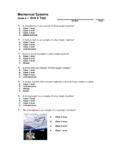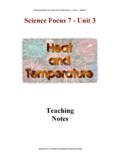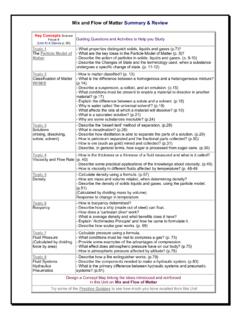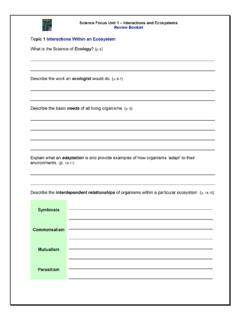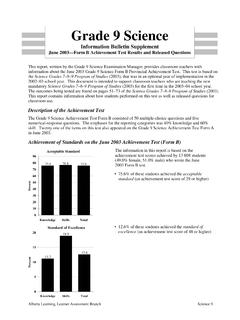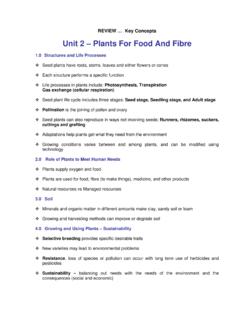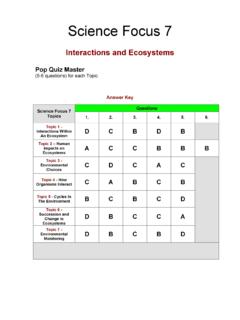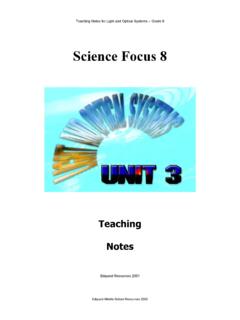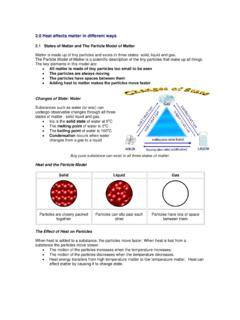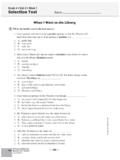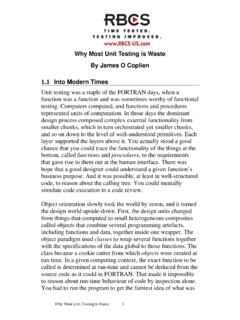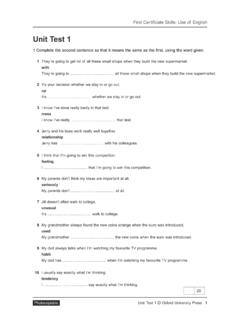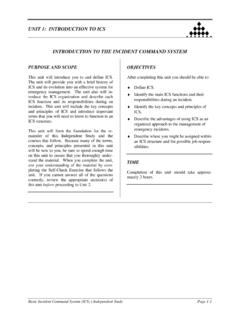Transcription of Biological Diversity Unit Test - EDQUEST SCIENCE
1 SCIENCE Focus 9 Biological Diversity unit Test _____ Name Class Biological Diversity unit Test 1. The most successful life form seems to be the insect. It is a species - a particular group of organisms that have the same structure and A. have the same predators B. consume the same food supply C. live in the same area D. reproduce with each other 2. The main components of biodiversity occurring within organisms at a cellular level, as it describes the variety of life producing material carrying the variation information in all living things is called .. A. Ecosystem Diversity B. Community Diversity C. Species Diversity D. Genetic Diversity 3. Foresters might decide to burn one part of a forest A. disease is likely to kill off all the trees in the forest, so they give nature a helping hand B. sacrificing one part of the ecosystem to save the main parts is also necessary sometimes C.
2 Habitat is increasing to such an extent that some forest species have to be displaced D. interspecies reproduction might destroy the natural forest ecosystem balance 4. This compares kinds of species in a certain area with the total number of organisms in that same area, or ecosystem. It is primarily used to check on the health of an ecosystem a healthy ecosystem has a A. low Diversity index B. high Diversity index C. high variation level D. low variation level 5. What it eats, its habitat, nesting site, range and habits, what effect it has on the other populations and what effect it has on the environment is the role that an organism has within a particular ecosystem called a .. A. niche B. species C. variation D. adaptation 6. Some bird species, like warblers, share resources by accessing these resources in different ways. They avoid direct competition for the same resource, by practicing a technique called.
3 A. food supply sharing B. nutrient cooperation C. resource partitioning D. interspecies sharing 7. Canada supports large populations with little Diversity in the extreme northern environment and seasonal variations. The reason this restricts species Diversity is because of the limited .. A. habitats B. diseases C. competition D. food supply 8. Different types of ongoing relationships between and among all the organisms, within a particular environment, are represented by .. A. food chains and food webs B. niches and speciation C. competition and predation D. adaptation and habitation SCIENCE Focus 9 Biological Diversity unit Test 9. A different type of interdependence is an association, within a certain population, between members of different species happens when two or more species need the same resource. This type of relationship which helps to limit the size of populations, of the competing species is called A.
4 Mutualism B. parasitism C. commensalism D. interspecies competition 10. There are different types of asexual reproduction: When the cell duplicates its contents, including its nucleus and other organelles and then splits into two cells with each one being identical (bacteria, amoeba, algae) - only single-celled organisms reproduce in this way it is called .. A. budding B. tuber formation C. binary fission D. spore production 11. Spores are similar to seeds, but are produced by the division of cells on the parent, not by the union of two cells. Some fungi and green algae can also produce types of spores that move using tail-like flagella and are called .. A. paramecium B. flagella spores C. pseudopods D. zoospores 12. Plants continue to grow throughout their lives. The rapidly growing tips of roots and stems contain specialized cells called meristems that function in the process of.
5 A. reproduction B. transportation C. photosynthesis D. respiration 13. A primitive form of sexual reproduction in which bacteria are able to transfer genetic material directly from one cell to another is called bacterial conjugation. Because there is no increase in the number of cells, it does result in A. redistribution B. recombination C. reconstitution D. recovery 14. Plants which are not identical to either parent plant are produced as a result of .. A. zygote growth B. cross-fertilization C. embryo development D. self-pollination 15. The pistil is composed of the following flower parts .. A. ovary, filament, stigma B. stamen, stigma, ovary C. anther, ovary, stigma D. stigma, style, ovary 16. Inherited (heritable) characteristics are those traits that are passed on to offspring directly from their parents. Heritable traits include, structural and distinguishing characteristics.
6 All of the following are heritable traits, except .. A. earlobes B. skin color C. eye color D. artistic ability SCIENCE Focus 9 Biological Diversity unit Test 17. Continuous variations are differences in characteristics that have a range of possible variations. Discrete variations are differences in characteristics that have a definite form, with a limited number of possibilities. The only discrete variation included here is .. A. hair color B. blood groups C. earlobe attachment D. tongue rolling ability 18. Having six fingers on one hand is relatively rare in the general population. The following is the only true statement about this unique trait, It is an inherited trait that is .. A. recessive with a low frequency B. recessive with a high frequency C. dominant with a low frequency D. dominant with a high frequency 19. Non-inherited characteristics are acquired and not necessarily passed on from generation to generation.
7 Some variations may be influenced by interactions with A. parents B. scientists C. engineers D. environment 20. Mutations can cause changes in the structure of organisms, including people. Mutagens, cause mutations to occur some that have little visible effects and some that have dramatic effects. The mutagen that would have the most dramatic effect in a person would likely be .. A. x-rays B. gamma rays C. microwaves D. ultraviolet rays 21. The DNA molecule is like a ladder twisted into a spiral The sides of the ladder are the same in all DNA molecules, but the rungs are what make the variations. Each rung pairs up two of the following chemicals: guanine (G), cystosine (C), adenine (A) and thiamine (T). The arrangement of these four chemicals creates the code that the cells are able to interpret. This code is called the .. A. Genetic code B. M utagen code C. Variation code D.
8 Chromosome code 22. 46 tightly coiled strands of DNA in humans represent the full compliment of .. A. gametes B. sperm cells C. egg cells D. chromosomes 23. Different human cells (somatic cells) have different life spans. Brain cells 30-50 years Replication of the contents of each cell occurs when the cell reproduces. Red blood cells 120 days Stomach lining cells 2 days Liver cells 200 days Intestine lining cells 3 days Skin cells 20 days When a cell divides, each cell ends up with a complete set of chromosomes, identical to each other and identical to the original cell. This process of Mitosis occurs most frequently in .. A. skin cells B. liver cells C. intestine lining cells D. stomach lining cells SCIENCE Focus 9 Biological Diversity unit Test 24. This type of sexual reproduction within a species increases .. A. variation B. mutations C. vulnerability D. specialization 25.
9 Moving pieces of one strand of DNA to other cells is a relatively new technique that has emerged. In the SCIENCE of genetics, this technique has enabled scientists to create individuals within a species with desirable traits and is called .. A. biodiversity B. biomagnification C. genetic Diversity D. genetic engineering 26. One of the first uses of modern biotechnology was to move a human gene into bacteria. By doing this, bacteria were able to produce as a waste product, large quantities of a drug, used by diabetes patients, called .. A. Aspirin B. Insulin C. Tylenol D. Quinine 27. Aquaculture is becoming an increasingly important method of mass production fish farming, however, if these special fish make it out into the open ocean, what organisms be negatively affected? A. fishermen and biologists B. predator populations C. natural fish population D. large mammal population 28.
10 To produce purebred organisms, a breeder would choose purebred parents, those parents whose ancestors have produced only the desired characteristic. If a breeder chooses two different 'true-breeds', then the offspring produced would be a .. A. domestic B. mutant C. gamete D. hybrid 29. Long before the SCIENCE of genetics started, people tried to reproduce organisms with only the most preferred traits, by allowing only those organisms with the desirable traits to reproduce. This method was not always successful, but it provided scientists with information to help them determine which alleles were responsible for specific traits through .. A. organization B. trial and error C. scientific research D. opinion and thought 30. The process of intervention to produce more desirable organisms takes a long time to see results - usually many generations. Speeding up the artificial selection process by using cells to make new cells is called.
